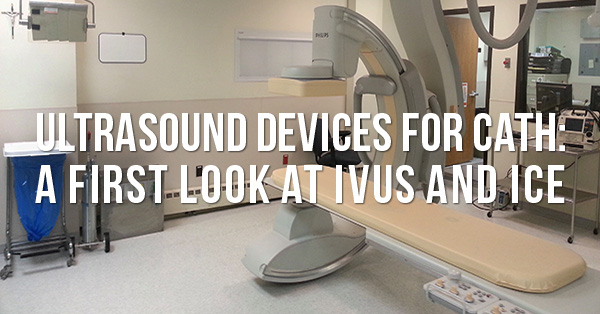
Updated: May 28, 2025 : 2 min read
IVUS and ICE Ultrasound Imaging in the Cath Lab: What Are They?
In the cath lab world there are many peripheral items that can be used during catheterization to adapt a lab to the needs of hundreds of procedures. Today we’re going to focus on just one peripheral type, ultrasound devices; specifically IVUS and ICE. These devices have similar but distinct applications that can sometimes be easy to confuse. We'll clarify what each is and how it's used in conjunction with a cath lab below.
What Is IVUS Imaging?
Most often we hear the term intravascular ultrasound (IVUS) tossed around to indicate any ultrasound imaging from inside the body. Specifically, IVUS is used to image the inside of arteries to check their condition. Measurements of blood vessels can be taken to determine the size and severity of blockages to help determine treatment paths.
What Is ICE Imaging?
ICE stands for intra-cardiac echocardiography. While similar to IVUS, transmitting ultrasound signals within the body, ICE is designed to image inside the heart using Doppler imaging. This allows the physicians to see structures and blood flow inside the heart. In addition, ICE imaging can be used for guidance of ablation catheters during electrophysiology procedures.
Manufacturers of IVUS and ICE Units
In the overall landscape of ultrasound imaging, there are many manufactures trying to get their piece of the pie. This is not the case when it comes to IVUS and ICE imaging. As this imaging is much more specialized, there are relatively few manufacturers to choose from.
For IVUS imaging, you can choose between Volcano (owned by Philips) and Boston Scientific. Both units require the use of their own disposable IVUS catheters, locking you into purchasing their proprietary consumables for as long as you own the equipment.
With ICE imaging, there are more options available. At last check, units with ICE imaging capabilities were available from GE, Siemens, Boston Scientific, and St. Jude Medical. Similar to IVUS, once a unit is selected, you’re married to that manufacturer’s consumables for the life of the equipment
Where Can I Get an IVUS or ICE Unit, and How Much Will It Cost?
Ah, the magic question, and one that, in this case, requires an asterisk.
Due to the lack of competition and availability on the secondary market for IVUS systems, chances are you’ll have to partner directly with an OEM in order to purchase a unit. While the OEMs are protective of their pricing, it appears the costs for a new unit are in the $80,000 - $200,000 range.
On the ICE side, there is good news. With the added competition and manufacturing of units by GE and Siemens, these units can be found on the secondary market. Depending on the model, date of manufacture, and options, a good used or refurbished unit falls in the $30,000 - $60,000 range.
"So what’s the asterisk?" you ask. The consumables! Once the initial outlay of cash is done, you’ll have to start purchasing the required disposable catheters. While we don’t have specific costs, our research points to IVUS catheters in the $600 - $1200 range, while the ICE catheters seem more “reasonable” in the $400 - $700 range.
The Takeaway
There's no doubt that IVUS and ICE imaging devices expand capabilities in the cath lab suite. The visibility they provide in vascular structures and the heart can help increase accuracy in patient diagnosis and treatment. There are also additional reimbursements for using them in conjunction with your lab. It's worth noting however, that both device types come with the ongoing expense of stocking consumables.
If you’re considering adding IVUS or ICE imaging to your cath lab, or if you’re in need of a complete cath lab suite, and have questions, don’t hesitate to give us a call or shoot us an email.

Kenn Dextrom
Kenn Dextrom is the Director of Product Manager at Block Imaging. He aims to provide clear direction and careful planning for Interventional Cath Lab buyers and working with the Block Imaging product team to provide excellent solutions for our customers. Out of the office, he spends most of his time keeping up with his wife and their three energetic sons.




